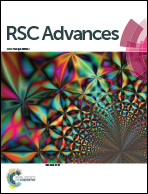Isothiocyanato and azido coordination induced structural diversity in zinc(ii) complexes with Schiff base containing tetrahydrofuran group: synthesis, characterization, crystal structure and fluorescence study†
Abstract
Three new structurally diverse zinc(II) complexes of formula [H3O][ZnL2]ClO4 (1), [Zn2(μ-L)2(NCS)2] (2) and [Zn3(μ-L)2(μ-N3)4]n (3) have been synthesized using the same furan-based tridentate ONO-donor Schiff base ligand HL (2-hydroxybenzyl-2-tetrahydrofurylmethyl)imine and characterized by X-ray structural analysis. Complex 1 is mononuclear, whereas 2 is a double phenoxido-bridged dinuclear compound. The novel polymeric compound 3 from azido coordination driven aggregation possesses a very rare 1D structure in which the dinuclear ligand-bound Zn2L2 fragments are bridged by four ligand-free μ1,1-azido bridging Zn(N3)42− units resulting in a zigzag arrangement of repeating triangular Zn3 motifs with structural similarity to the P1 nuclease. Solid state mixing and grinding processes were applied for the ligand exchange reaction and core conversion. In mechanochemical solvent free synthetic routes 1 reacts with isothiocyanato and azido ions to provide 2 and 3 in pure form. The ligand HL serves as sensitive fluorescent probe for Zn2+, and complex 1 for SCN− and N3− ions in MeOH medium. Coordination induced fluorescence enhancement due to intraligand π → π* transition in the presence of Zn2+ of HL and quenching of emission intensities of 1 with SCN− and N3− anions are accounted for by the formation of hitherto unknown complexes [Zn(L)(X)] (where X = ClO4−, SCN− and N3−). HL shows chelation-enhanced fluorescence response from strong metal ion coordination and binding of isothiocyanato and azido anions with an appreciable lifetime of the fluorophore signals. Excitation at 380 nm of MeOH solutions of all three complexes in air exhibit excited state life-time spanning from 2.5–4.8 ns.


 Please wait while we load your content...
Please wait while we load your content...